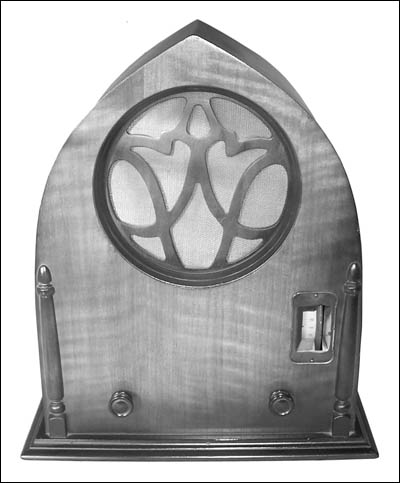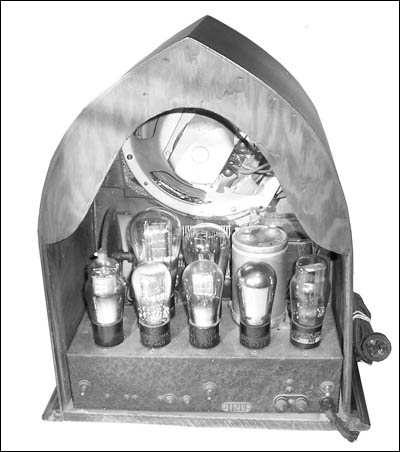Of Old Radios And Related Items--Published Monthly
The 1930-1931 Aztec Cathedral
By Richard Arnold with information contributed by Robert A. Lane
Web Edition
In this article Richard Arnold presents the story of a set with an interesting history, but one not often seen. Another early radio pioneer, Fred W. Stein, is also remembered. (Editor)
The 1930 Aztec cathedral, shown in Figure 1, was manufactured by Fred W. Stein, who designed the Steinite radios and offered the world one of the first electric receiver. This is one of a few sets Stein made under his own name in 1930-1931 before he went bankrupt. There is a small brown piece of paper glued inside the cabinet that says "Fred W. Stein."
The Aztec cathedral is a tuned radio frequency (TRF) radio that uses the following tubes: two Type 245s as push-pull, AF power tubes; three Type 224s as 1st, 2nd, and 3rd RFs; a Type 80 rectifier; and a Type 224 detector. A rear view of the cabinet and chassis is shown in Figure 2.
The cabinet shows the small round speaker opening that usually indicates early model cathedrals. The grille cloth is original.
The two knobs on the front of the cabinet are used as a variometer and volume control. A lighted drum dial tunes in the stations. There are two switches on the back of the chassis: One is the on/off switch, while the other is a high/low switch.
A promotional ad to entice dealers to sell the Aztec says, "Dollar for dollar, you will find it hard to beat the Aztec for value. It is the outstanding offer of the day... Gives a real 7-tube "AC" radio complete with tubes and Magnavox Dynamic Speaker at a price that is less than many inferior models... Read the many points of merit and you will see why the Aztec is selling like hot cakes in every locality."
The twelve "Points of Merit" are as follows:
- Genuine Walnut Gothic Design Cabinet
- Magnavox Lifetime Dynamic Speaker
- Push-Pull Amplification with 245 Power Tubes
- Three Stages of Tuned Radio Frequency
- Screen Grid Tube as Detector
- Balanced Radio Frequency Coils
- Sturdy Construction Shielded Steel Chassis
- Single Dial Control
- Kilocycle Dial for Accurate Tuning
- Efficient Sensitivity Tuning
- Illuminated Dial for Easy Tuning
- New Tone Control and a Phonograph Pickup Jack
All of this and the radio only cost the dealer $38.70. The recommended retail price was $64.50. To sweeten the deal for the dealer, he could even get a 3 percent cash discount on top of the low price if he sent in cash with his order.
Portrait of
Fred W. SteinWho was Fred W. Stein? Well, about twenty years ago when I first started gathering information on this radio, I contacted Dr. Robert A. Lane, an optometrist, who lived in Kansas City, Missouri. Dr. Lane had visited with Mr. Stein at his home in Atchison, Kansas, in October of 1971. He had his camera and recorder with him, and he interviewed Mr. Stein and his son Fred Stein, Jr.
Figure 1. The 1930-1931 Aztec cathedral, one of the few sets manufactured by Fred W. Stein, designer of Steinite radios.Lane was kind enough to furnish me with some pictures of the two Mr. Steins, as well as a handwritten copy of the story he wrote after the interview. Here is his story:
"It was a cool October day in 1971 when I drove the forty miles from Kansas City to Atchison, Kansas, to meet Fred W. Stein. He was happy to see me and talked for over an hour. Luckily, I had brought my recorder and camera with me.
Mr. Stein was a self-taught electronics engineer who completed his formal education with the eighth grade. He played with telegraphy and then wireless when he was a boy. He had a three-year apprenticeship with the Kansas Railway Power and Light Company in Atchison after he left school.
In 1908, he started an electrical business with a friend, and then an electrical contracting business on his own. After serving in the Navy in the war, he started selling galena crystals for 50 cents or three for a dollar. A large ad in the Kansas City Star brought him a surprisingly large response, and he sold his "long range crystals, with a 1,000-mile range" by the thousands. Luckily, not many people complained.
He then sold the complete crystal detectors for $1. In 1923, he began selling his famous crystal radios for $6, and with few changes, sold them through 1925. An all-wooden crystal set with a dial below the panel was sold for the next two years.
Figure 2. A rear view of the Aztec cathedral cabinet and chassis. Note the two switches, one for on/off, the other for high/low.A 1-tube set for $12 and a 2-tube set for $16 were sold in 1924-25. His popular radio interference wave traps were sold for $1 the same year. In 1925, he made a 2-tube amplifier and a 5-tube TRF set.
His first AC radio was made in 1926 using a built-in power supply with Type UX-199 tubes in series. There were two cabinets made for the table model -- the deluxe set had a built-in speaker. A console model was sold also.
Business was so good that his factory was enlarged three times until he had 1,185 employees producing 20,000 radios a month before the Depression hit.
Stein sold the business in 1924 to a Chicago firm, which moved it to Fort Wayne, Indiana. However, the company went broke around 1932. In 19310-1931, he started making a few sets under his own name, Fred W. Stein, but he also went bankrupt."
Though the radio business went under fairly soon, Stein Laboratories continued to develop electronic equipment in Achison for years to come.
The Fred W. Stein cathedral radio is very rare and is a beautiful tribute to the life of one of early radio's great pioneers. Stein died in Atchison, Kansas, on November 27, 1972, at the age of 84. A Kansas City Observer obituary suggested that he be celebrated as Atchison's "Favorite Son," just as Amelia Earhart is its "Favorite Daughter ."
References:
Lane, Robert A. Fred W. Stein interview, Oct. 1971.
Hayslett, Jack. "Tales from Old Atchison" Atchison Enquirer online; Kansas City Star obituary of Fred W. Stein.
Burstein-Applebee Company Dealer Promotion Ad.
(Richard Arnold, P.O., Box 275, Lone Grove, OK 73443)
Richard Arnold, a frequent contributor to A.R.C., has been collecting radios since 1985. His interest is primarily in cathedrals and 1920s battery sets, and his collection ranges from crystal sets to a 1928 American Bosch in a Pooley cabinet. His prize is the 1932 Jackson Bell Peter Pan featured in the June 1991 A.R.C.
| [Free Sample] [Books, etc., For Sale] [Subscribe to A.R.C./Renew] [Classified Ads] [Auction Prices] [Event Calendar] [Links] [Home] [Issue Archives] [Book Reviews] [Subscription Information] [A.R.C. FAQ] URL = http://www.antiqueradio.com/Aug07_Arnold_Aztec.html Copyright © 1996-2007 by John V. Terrey - For personal use only. Last revised: July 30, 2007. For Customer Assistance please contact ARC@antiqueradio.com or call (866) 371-0512 toll free Pages designed/maintained by Wayward Fluffy Publications
Antique Radio Classified |

